Overview of modern energy-saving heating systems: save on heat
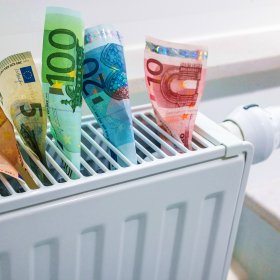
Owners of private housing will certainly be interested in the issue of saving money on the installation of the heating system, which, due to the regular increase in gas and electricity tariffs, becomes especially relevant. The optimal solution to the budget problem is to install efficient equipment that can reduce costs. We suggest paying attention to energy-saving systems that rationally use resources and allow good savings.
Content
Energy Efficiency of Traditional Heating Systems
Modification of familiar, often used heating systems can affect energy costs. For example, application thermostatic valve save up to 20% of energy resources. It is installed on the pipe directly in front of the radiator and allows you to adjust the heat transfer of the heater.
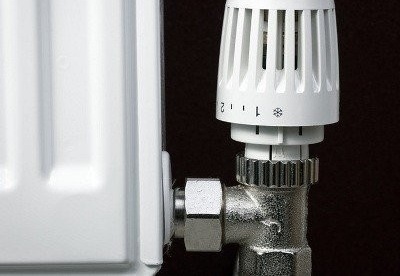
To maintain the set temperature in the room, the thermostatic valve can be switched to automatic mode by installing additional temperature sensors
Instead of introducing one part, you can completely replace the boiler or stove with more modern equipment, originally created to save energy resources.
Modified furnaces and boilers
If the heating system at home is out of date, there is a wonderful way to reduce energy consumption. Along with the device of high-quality thermal insulation, it is worth simply replacing the old equipment with the improved one: a new boiler, an oil or gas stove. The efficiency of new systems is 90% and higher.
Thanks to the branched duct system, modern furnaces provide heat to every room in the house, and boilers supply heated liquid not only to radiators, but also to warm floor.
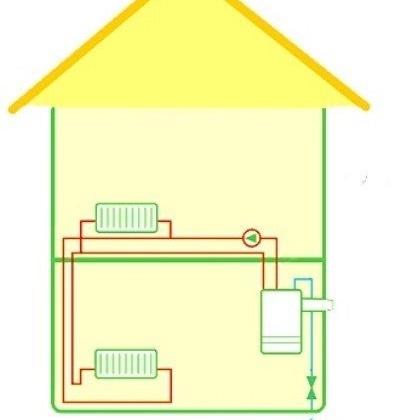
When modernized boilers and stoves are used as energy-efficient equipment in a private house, the efficiency of the heating system increases to 92-94%
Ignition-flame equipment was replaced by boilers with electric ignition, which, coupled with more efficient condensers and heat exchangers, reduces fuel consumption. The ventilation system has also changed. The combustion chamber is ventilated not by internal air, as before, but by external air, i.e. the air in the rooms is practically not polluted.
As a result of structural changes, boilers and furnaces operating on propane, gas or fuel oil have moved into the category of more economical fuel consumption, and their environmental class has also grown.
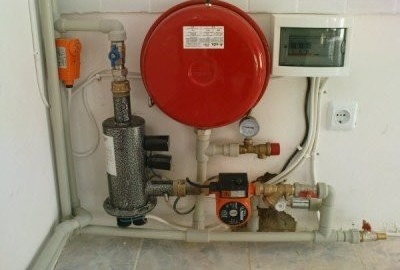
Modern electric boilers do not require a separate room and occupy a minimum of free space, so they can be installed in any convenient place for maintenance
Wood stove heating
A large number of renewable resources such as wood still make wood-burning stoves popular outside the city. The simple design of the heating equipment is not much different from traditional village stoves: these are cast-iron or steel devices equipped with a primitive ventilation system. Although modern furnaces are more comfortable than previous devices, they are considered the most dangerous - the slightest violation in the design or untimely cleaning can cause a fire.
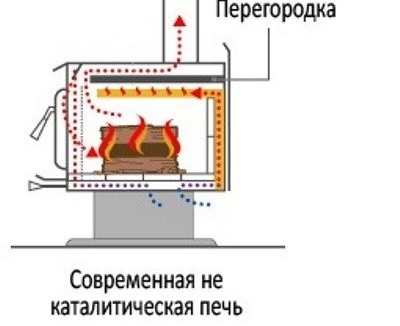
In detached houses that are not connected to the central power supply system, it is possible to use a modern wood stove: the amount of pollution from it is much less than from a conventional stove
Wood stoves have a very low efficiency - as a rule, they only heat the rooms in which they are located, that is, 1-2 rooms. It is possible to increase work efficiency by installing a combined gas-wood variant, which uses not only wood but also natural gas as fuel. When using equipment of this type, the heating area increases due to the branched duct system.
There is a type of furnace operating on the principle of a boiler. They heat up coolant - water circulating through pipes. Such equipment is safer, as it is located outside the residential building.
Economical heat pumps
Energy efficiency heat pumps built on the features of their work: they produce heat from water and air. According to the same sign, devices are divided into two groups:
- geotemal, functioning due to the heat of the earth;
- air, extracting heat from the atmosphere.
Geothermal pumps equipped with a system of wells reaching a depth of 200 m, or with a horizontal pipeline laid below the freezing zone of the soil. If necessary, they can heat water, although not to the maximum, but to about + 55 ° C.
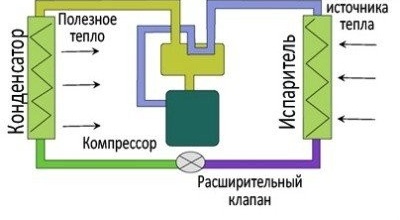
The energy efficiency of geothermal and air heat pumps is quite high: each used 1 W of electrical energy is converted into 3-4 W of thermal energy
Air pumps are able to generate heat from the air even in a 20-degree frost thanks to the refrigeration principle of operation. Heated air is distributed through the building using pipes. One of the advantages of heat pumps is their reverse operation: in the summer heat, they can cool the rooms.
An affordable sample of heating equipment - the system "mini split”, Consisting of indoor and outdoor modules. Air heat pumps are much cheaper and more affordable for cottages than geothermal installations.
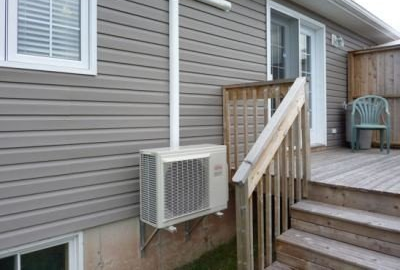
An outdoor unit installed on the street takes cold air and heats (or cools) it. Instead of a duct system inside the building, panels are installed through which heated air enters the premises
Monolithic Quartz Electric Heaters
Monolithic quartz heaters are small-sized mobile panels that can be evenly distributed around the perimeter of the room.
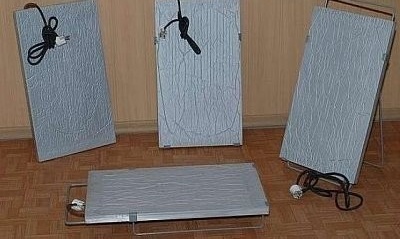
The surface of monolithic quartz modules does not heat up above 95 degrees, therefore, they are fireproof and do not cause drying of the air in the room
The source of energy for quartz heaters is electricity, however, using them can reduce consumption due to two factors:
- The principle of operation of the device is associated with periodic heating of quartz sand, which is able to accumulate heat even after a power outage. The operation of the device is similar to the work of a Russian stove, which is first heated with wood, and then it slowly cools down, heating the room.The role of firewood is performed by the chromium-nickel heating element, mounted inside the device and having a long service life.
- A system of quartz modules will be more economical if equipped with air temperature controllers. Using automatic adjustment, it is easy to achieve the desired temperature, without overheating and excessive heat transfer.
Quartz steel heaters were actively produced at the end of the 90s of the last century, but they had already won their active consumer. In addition to summer residents, who are constantly living outside the city, owners of public institutions - schools, kindergartens, libraries, became interested in heaters. They are also relevant for heating offices that require the installation of a small number of modules: one device heats up 15 m³ of space. To provide heat to a spacious room, a system should be installed from a certain number of parallel installed panels.
Quartz heaters are perfect for anyone who appreciates ease of use and installation, affordable cost and savings.
Infrared Film Panels
At infrared heaters there are supporters and opponents. Many see them as heating the future - efficient, environmentally friendly, absolutely safe heating appliances are installed in any part of the house: on the walls, ceiling and even in the floor. But ease of installation is not the main plus of film panels.
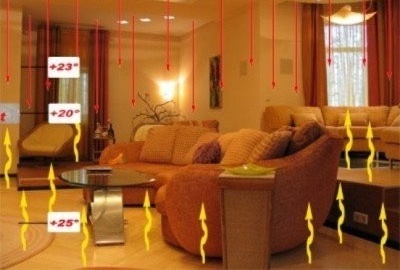
When buying an infrared heater, pay attention to such a characteristic as the estimated installation height. The most common parameters are from 2.1 to 3.2 m
Infrared equipment hit the wide market back in 1967 and immediately became popular thanks to a completely new operating principle. The panels heat, like the sun's rays, not the air in the room, but the surrounding objects, as a result, all surfaces in the room begin to radiate heat. The functionality of devices comfortable for residents is complemented by aesthetic appeal, which interior designers willingly use.
The heating process evenly distributes heat throughout the room, so there is no sharp difference between the air temperature near the floor and under the ceiling. The absence of temperature changes saves electricity by as much as 60%.
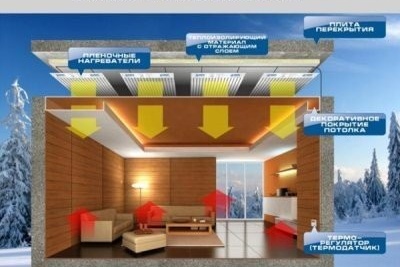
There are two common types of installation of infrared film panels: directly on the ceiling or under a decorative surface, which is not an obstacle for and / to rays
An example of infrared equipment is PLEN system, which can completely replace central heating. Manufacturers give 50 years of operation without additional maintenance and 10 years of warranty. The power consumption of the system is not more than 20 W / m² per hour. A thin film in the laminate is attached to the selected place and does not clutter up the room, as heating radiators do. PLEN products are manufactured, so it is easy to purchase from dealers anywhere in the country.
Use of solar energy
Solar heat is an environmentally friendly and quite effective source for the installation of a number of heating systems. Some modifications use electricity as additional power, others work only from solar cells. In some cases, additional equipment is not necessary - enough sunlight.
Air Modular Manifolds
Solar panels (collectors) they are installed on the south side of the building at such an angle that their heating by sunlight is maximum. The system operates in automatic mode: when the air temperature drops below a predetermined mark, air is driven through the heating modules using fans. One air battery allows you to heat a room with an area of up to 40 m², respectively, a set of collectors is able to serve the whole house.
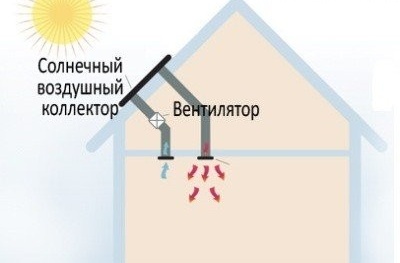
For the southern regions, modular type solar air collectors are quite effective and inexpensive equipment for creating a heating system
Solar modules environmentally friendly and cost-effective, they are convenient to use in conjunction with other heating systems as a backup source of energy. The design of the devices is simple, so there are DIY assembly schemes for solar panels. Ready-made collectors are also affordable and quickly pay off. The only thing that needs to be done before buying them is to calculate the power of the equipment and the size of the modules.
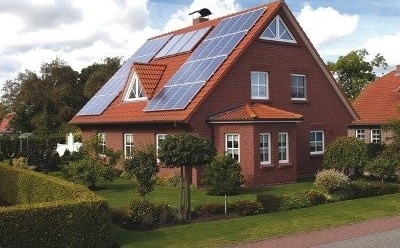
In cottages and country houses, solar batteries are installed for backup power supply of direct current 12/24/48 Volts of small power or AC loads of 220 Volts
Air-water collectors
Hot water systems powered by solar energy are suitable for any climate. The principle of operation of the system is simple: the water heated in the collectors flows through the pipes into the storage tank, and from it - throughout the house. The fluid is constantly circulated by the pump, so the process is continuous. Several solar collectors and two large reservoirs can provide cottage with heat - of course, provided that there will be enough sun. High-temperature collectors allow installing a “warm floor”.
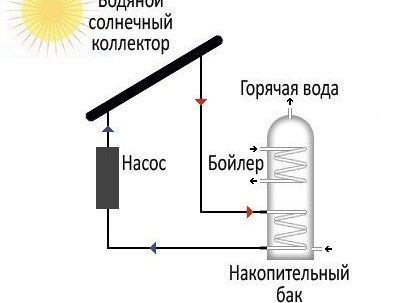
Solar hot water systems do not completely pollute the air and do not make noise, but additional equipment is required for their installation: a pump, a pair of storage tanks, a boiler, a pipeline
The advantage of equipment working on water collectors is environmental friendliness. Silence and clean air inside the house are no less important than heating and hot water. Before installing solar collectors, it is necessary to calculate how effective they will be in a particular case, because for the full work all the nuances are important: from the installation site to the estimated power of the devices. One drawback should be taken into account - in areas with a long summer period, an excess of heated water will appear, which will have to be drained into the ground.
Passive type solar heating
Passive solar heating does not require additional equipment. The main conditions are three factors:
- perfect tightness and thermal insulation of the house;
- sunny, cloudless weather;
- optimal location of the house in relation to the sun.
One option suitable for installing such a system is a frame house with large glass windows facing south. The sun heats the house both from the outside and from the inside, as its heat is absorbed by walls and floors.

Using passive solar equipment, without the use of power and expensive pumps, you can save 60-80% of the cost of heating a private house
Thanks to the passive system in sunny areas, savings in heating costs exceed 80%. In the northern regions, this heating method is not effective, therefore, it is used as an additional one.
All energy-saving heating systems have advantages over conventional ones, the main thing is to choose the most optimal, possibly combined option, combining work efficiency and saving resources.

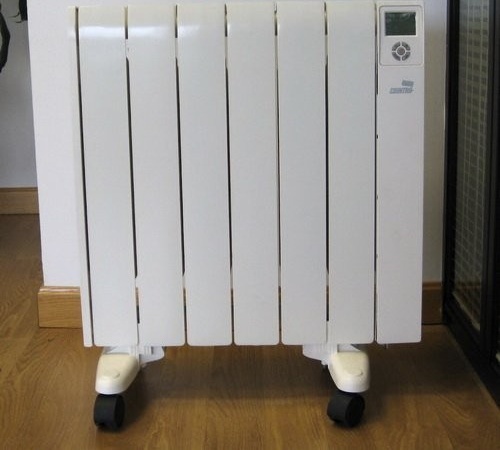

1 comment